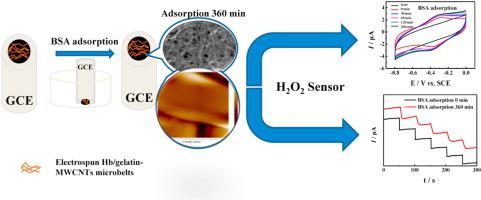当前位置:
X-MOL 学术
›
Mater. Chem. Phys.
›
论文详情
Our official English website, www.x-mol.net, welcomes your
feedback! (Note: you will need to create a separate account there.)
Effect of protein adsorption on electrospun hemoglobin/gelatin-MWCNTs microbelts modified electrode: toward electrochemical measurement of hydrogen peroxide
Materials Chemistry and Physics ( IF 4.3 ) Pub Date : 2021-01-01 , DOI: 10.1016/j.matchemphys.2020.123827 Z.X. Deng , J.W. Tao , W. Zhang , H.J. Mu , H.J. Wu , Y.B. Wang , X.X. Xu , W. Zheng
Materials Chemistry and Physics ( IF 4.3 ) Pub Date : 2021-01-01 , DOI: 10.1016/j.matchemphys.2020.123827 Z.X. Deng , J.W. Tao , W. Zhang , H.J. Mu , H.J. Wu , Y.B. Wang , X.X. Xu , W. Zheng

|
Abstract The on-line electrochemical analysis is one of powerful strategies in analytical chemistry and pathophysiology. To achieve high sensitivity and long-term stability of electrochemical biosensor, the bottleneck challenge is the spontaneous proteins adsorption onto the electrode surface within the biological fluids or in vivo environments. In this work, a hemoglobin/gelatin-multiwalled carbon nanotubes microbelts modified electrode (Hb/gelatin-MWCNTs/GC electrode) was successfully fabricated via one-step electrospinning process. The results of atomic force microscopy (AFM), scanning electron microscopy (SEM) and water contact angle test confirmed the electrospun Hb/gelatin-MWCNTs microbelts possessed smooth and hydrophilic surfaces. Furthermore, the electrospun Hb/gelatin-MWCNTs/GC electrode after protein adsorption displayed an excellent electrocatalytic sensitivity toward the reduction of hydrogen peroxide (H2O2). Moreover, the Hb/gelatin-MWCNTs/GC electrode presented very high biological affinity to H2O2 ( K m app =503.4 ± 2.8 μmol L−1) after 360 min protein adsorption compared to that of the electrode before protein adsorption ( K m app =298.1 ± 3.1 μmol L−1). The microbelts constructed H2O2 biosensor showed high selectivity, stability and reproducibility after protein adsorption. Therefore, this work provided the proof of the concept that the electrospun Hb/gelatin-MWCNTs/GC electrode displayed excellent sensing performance to H2O2 after protein adsorption, which could enable the implantable electrochemical biosensor for the on-line analysis.
中文翻译:

蛋白质吸附对电纺血红蛋白/明胶-MWCNTs微带修饰电极的影响:对过氧化氢的电化学测量
摘要 在线电化学分析是分析化学和病理生理学的有力策略之一。为了实现电化学生物传感器的高灵敏度和长期稳定性,瓶颈挑战是自发的蛋白质吸附在生物体液或体内环境中的电极表面上。在这项工作中,通过一步静电纺丝工艺成功制造了血红蛋白/明胶-多壁碳纳米管微带修饰电极(Hb/明胶-MWCNTs/GC电极)。原子力显微镜 (AFM)、扫描电子显微镜 (SEM) 和水接触角测试的结果证实了电纺 Hb/明胶-MWCNTs 微带具有光滑和亲水的表面。此外,蛋白质吸附后的电纺 Hb/明胶-MWCNTs/GC 电极对过氧化氢 (H2O2) 的还原显示出极好的电催化敏感性。此外,与蛋白质吸附前的电极相比,Hb/明胶-MWCNTs/GC 电极在蛋白质吸附 360 分钟后对 H2O2 表现出非常高的生物亲和力(K m app =503.4 ± 2.8 μmol L-1)(K m app = 298.1 ± 3.1 μmol L−1)。微带构建的H2O2生物传感器在蛋白质吸附后表现出较高的选择性、稳定性和重现性。因此,这项工作证明了电纺Hb/明胶-MWCNTs/GC电极在蛋白质吸附后对H2O2表现出优异的传感性能的概念,这可以使植入式电化学生物传感器用于在线分析。
更新日期:2021-01-01
中文翻译:

蛋白质吸附对电纺血红蛋白/明胶-MWCNTs微带修饰电极的影响:对过氧化氢的电化学测量
摘要 在线电化学分析是分析化学和病理生理学的有力策略之一。为了实现电化学生物传感器的高灵敏度和长期稳定性,瓶颈挑战是自发的蛋白质吸附在生物体液或体内环境中的电极表面上。在这项工作中,通过一步静电纺丝工艺成功制造了血红蛋白/明胶-多壁碳纳米管微带修饰电极(Hb/明胶-MWCNTs/GC电极)。原子力显微镜 (AFM)、扫描电子显微镜 (SEM) 和水接触角测试的结果证实了电纺 Hb/明胶-MWCNTs 微带具有光滑和亲水的表面。此外,蛋白质吸附后的电纺 Hb/明胶-MWCNTs/GC 电极对过氧化氢 (H2O2) 的还原显示出极好的电催化敏感性。此外,与蛋白质吸附前的电极相比,Hb/明胶-MWCNTs/GC 电极在蛋白质吸附 360 分钟后对 H2O2 表现出非常高的生物亲和力(K m app =503.4 ± 2.8 μmol L-1)(K m app = 298.1 ± 3.1 μmol L−1)。微带构建的H2O2生物传感器在蛋白质吸附后表现出较高的选择性、稳定性和重现性。因此,这项工作证明了电纺Hb/明胶-MWCNTs/GC电极在蛋白质吸附后对H2O2表现出优异的传感性能的概念,这可以使植入式电化学生物传感器用于在线分析。











































 京公网安备 11010802027423号
京公网安备 11010802027423号